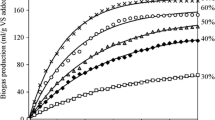Abstract
Improved organic loading rates for anaerobic bioconversion of cellulosic feedstocks are possible through high-solids processing. Additionally, the reduction in process water for such a system further improves the economics by reducing the overall size of the digestion system. However, mixing of high-solids materials is often viewed as an energy-intensive part of the process. Although the energy demand for high-solids mixing may be minimized by improving the agitator configuration and reducing the mixing speed, relatively little information is available for the actual horsepower requirements of a mechanically mixed high-solids digester system.
The effect of sludge total solids content and digester fill level on mixing power requirements was evaluated using a novel NREL laboratory-scale high-solids digester. Trends in horsepower requirements are shown that establish the optimum parameters for minimizing mixing energy requirements, while maintaining adequate solids blending for biological activity. The comparative relationship between laboratory-scale mixing energy estimates and those required for scale-up systems is also established.
Similar content being viewed by others
References
Overend, R. P. and Rivard, C. J. (1993),Proceedings of the First Conference of the Americas: Energy, Environment, Agriculture, and Industry.
Renewable Energy Systems, Inc. (1990),Refuse Conversion to Methane (RefCoM) Equipment and Research Development Program, Final Report to Argonne National Laboratory, Contract No. 82202401.
Smith, K.D. (1978)Proceedings from the Symposium on Energy from Biomass and Wastes, IGT, Chicago, IL, pp. 403–429.
James, S. C., Wiles, C. C., Swartzbaugh, J. T., and Smith, R. B. (1980),Biotechnol. Bioeng. Symp. 10, 259.
Begouen, O., Thiebaut, E., Pavia, A., and Peillex, J. P. (1988), inProc. of the Fifth Int. Symp. on Anaerobic Digestion, pp. 789–792.
de Baere, L. and Verstraete, W. (1984)Biocycle 25, 1.
Rivard, C. J., Himmel, M. E., Vinzant, T. B., Adney, W. S., Wyman, C. E., and Grohmann, K. (1989),Appl. Biochem. and Biotech. 20/21, 461.
Rivard, C. J., Himmel, M. E., Vinzant, T. B., Adney, W. S., Wyman, C. E., and Grohmann, K. (1990),Biotech. Lett. 12, 235.
Rivard, C. J. (1993),Appl. Biochem. Biotech.,39/40, 107.
Author information
Authors and Affiliations
Rights and permissions
About this article
Cite this article
Rivard, C.J., Kay, B.D., Kerbaugh, D.H. et al. Horsepower requirements for high-solids anaerobic digestion. Appl Biochem Biotechnol 51, 155–162 (1995). https://doi.org/10.1007/BF02933420
Issue Date:
DOI: https://doi.org/10.1007/BF02933420



